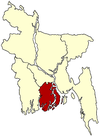Nesarabad (Swarupkati) Upazila
Nesarabad (Swarupkathi)
নেছারাবাদ (স্বরূপকাঠি) | |
|---|---|
Upazila | |
 Nesarabad (Swarupkathi) Location in Bangladesh | |
| Coordinates: 22°44.8′N 90°6.2′E / 22.7467°N 90.1033°ECoordinates: 22°44.8′N 90°6.2′E / 22.7467°N 90.1033°E | |
| Country | Bangladesh |
| Division | Barisal Division |
| District | Pirojpur District |
| Area | |
| • Total | 199.14 km2 (76.89 sq mi) |
| Population (1991) | |
| • Total | 202,520 |
| • Density | 1,000/km2 (2,600/sq mi) |
| Time zone | UTC+6 (BST) |
| Website | Official website of Neasarabad upazila |
Nesarabad (Swarupkathi) (Bengali: নেছারাবাদ (স্বরূপকাঠি)) is an upazila of Pirojpur District in the Division of Barisal, Bangladesh.[1] Nesarabad is famous for Sarsina Darbar Sharif. At present, guava gardens, floating market and backwaters of Nesarabad are turning into famous tourist attractions.
Geography[]
Nesarabad is located at 22°44′50″N 90°06′13″E / 22.7472°N 90.1036°E. It has 40,792 households and a total area of 199.14 km2.
Demographics[]
According to the 1991 Bangladesh census, Nesarabad had a population of 202,520. Males constituted 49.54% of the population, and females 50.46%. The population aged 18 or over was 107,488. Nesarabad had an average literacy rate of 50.8% (7+ years), compared to the national average of 32.4%.[2]
Nesarabad Upazila is divided into Swarupkati Municipality and ten union parishads: Atghar Kuriana, Baldia, Daihari, Guarekha, Jalabari, Nesarabad, Sarengkathi, Sohagdal, Somudoykathi, and Sutiakati. The union parishads are subdivided into 80 mauzas and 134 villages.[3]
Swarupkati Municipality is subdivided into 9 wards and 9 mahallas.[3]
See also[]
- Upazilas of Bangladesh
- Districts of Bangladesh
- Divisions of Bangladesh
References[]
- ^ Masud Parvez (2012). "Nesarabad (Swarupkathi) Upazila". In Sirajul Islam and Ahmed A. Jamal (ed.). Banglapedia: National Encyclopedia of Bangladesh (Second ed.). Asiatic Society of Bangladesh.
- ^ "Population Census Wing, BBS". Archived from the original on 2005-03-27. Retrieved November 10, 2006.
- ^ a b "District Statistics 2011: Pirojpur" (PDF). Bangladesh Bureau of Statistics. Archived from the original (PDF) on 13 November 2014. Retrieved 14 July 2014.
- Nesarabad (Swarupkati) Upazila
- Upazilas of Pirojpur District
- Barisal Division geography stubs

